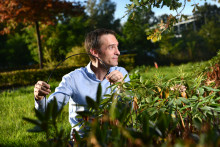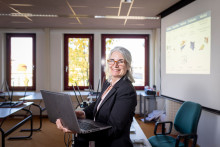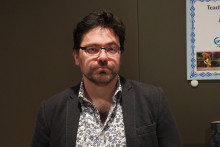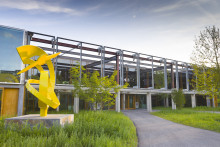When you think about climate change, you might see the clichéd images of dry riverbanks, desiccated animal carcasses, bare trees and sad-looking plants. These images are a bit misleading, says Christiaan van der Tol, researcher of Ecohydrology and Earth Observation. Plants and trees do not passively undergo the chances in our atmosphere. Instead, they not only respond to these changes; they actually affect them.
On the way to his office, the researcher pauses briefly at a poster that shows an image of tall coniferous trees. A man on a crane is dangling a sensor in one of the treetops. ‘That was part of research conducted in the Speulderbos in the province of Gelderland,’ Van der Tol explains. ‘Our measurements showed that 550 litres of rain per square metre reach the ground every year via a tree’s branches and its trunk. The rest, circa 200 litres per year, is caught at the top of the tree and evaporates. It then comes down as new rain at some point further inland.’
‘The balance between Earth’s atmosphere and its vegetation is the result of continuous interaction’
If it does not rain and a tree is at risk of overheating in the sun, that does not necessarily spell disaster. The leaves shed excess heat through evaporation and extract energy from the environment in the process. That, combined with the shadow of the canopy, is why a tree has such a cooling effect. That is not all, however. Plants can change the position of their leaves, allowing them to reflect more light than usual. The antennae that catch the light on the surface of the leaf also change direction. When that happens, photosynthesis, the process of turning water and carbon dioxide into oxygen and sugars, slows down. This produces less oxygen and traps more carbon dioxide in our atmosphere. On the other hand, the presence of more carbon dioxide in the air can lead to more plant growth, provided that there are sufficient quantities of sunlight, water and nutrients available. In other words: the balance between Earth’s atmosphere and its vegetation is the result of continuous interaction – and that does not even factor the impact of mankind and the world’s fauna into the equation.
Our climate under control
Increasing our control over climate change therefore requires more insight into the way in which plants and the atmosphere affect each other. To conduct that research on a large scale, the European Space Agency will launch a research satellite called FLEX in 2022. The satellite will be equipped with spectrometers that can detect light of different wavelengths. These past years, Van der Tol has contributed to the development of this technology.
‘Trees and plants emit fluorescent red and infrared light,’ the researcher explains. ‘That has to do with the photosynthesis taking place in the leaves. Miniscule antennae on the surface of a leaf catch the Sun’s photons (particles of light), which the leaves then turn into energy used for photosynthesis. Along the way, however, some of these photons escape in the form of fluorescent red and near-infrared light.’
The faster the photosynthesis, the less infrared light can escape in the process. That means the amount of infrared light released by a leaf in daylight says something about the plant’s activity and therefore about the amount of carbon dioxide it is turning into oxygen and sugars. A healthy plant that is exposed to plenty of light, water and nutrients uses a lot of light for its photosynthesis, but it also loses a certain amount of infrared light. A plant suffering from a lack of water and overheating will try to get rid of the photons as quickly as possible with the help of carotenes. These pigments quickly absorb the photons and turn the light into thermal radiation, allowing the plant to quickly get rid of its excess energy. This process leaves less light available for fluorescence and photosynthesis. If a plant releases an unexpectedly large amount of fluorescent (infrared) light, it may have been sprayed with herbicides. These cause the photons caught by the leaves’ antennae to become trapped. As a result, there is no photosynthesis and the light keeps bouncing around aimlessly inside the leaf until it ultimately bleeds out in the form of infrared light. All in all, the light spectrum emitted by plants during the day can reveal a whole lot about their conditions.

Floodlights
Of course, the infrared light released from plants and trees is not the only light that reaches the satellite. The spectrometers detect roughly a hundred times more reflected daylight than what the Earth’s vegetation emits as infrared light. It is no easy feat to detect the light from plants and trees amongst all that other light. Van der Tol: ‘It is like trying to detect the light from a nightlight in a room filled with massive floodlights.’
‘With this data, we can draw better conclusions about how the Earth’s vegetation affects the composition of our atmosphere’
The fluorescent light has a different colour than the reflected daylight. To accurately distinguish between the different wavelengths, spectrometers must utilise a specific shutter time to allow enough light to come in. The problem is that the Earth is not suspended motionlessly in space and neither is the satellite itself. ‘The satellite moves at a speed of seven kilometres per second,’ Van der Tol explains. ‘The longer the shutter time, the more difficult it becomes to focus on a small part of the planet.’ Here is an apt comparison: try taking a picture of a pedestrian while riding your bike in the dark; the longer the shutter time of your camera, the harder it is to capture a sharp image. More focus requires a shorter shutter time, but that will make the image too dark. Standing still for a few minutes is not an option for the satellite.
Until now, it was therefore only possible to detect reflected light of different wavelengths from an area of land several kilometres across. The new satellite’s improved technology reduces that number to just 300 metres. Van der Tol developed a mathematical model that translates the measurement data into information about the plants and trees from which the light originates: are they getting enough water and sunlight or do they face drought and overheating? What do these conditions say about the amount of carbon dioxide absorbed by the plants and the production of new biomass? ‘With this data, we can draw better conclusions about how the Earth’s vegetation affects the composition of our atmosphere,’ Van der Tol says.
Precision agriculture
A pilot version of the spectrometer was installed on an airplane and successfully tested earlier this year. If all goes well, FLEX will start producing usable measurement data in 2023. However, the model can also be used closer to ground level. ‘The same technology can be used for precision agriculture,’ the researcher explains. ‘You could mount a spectrometer on a drone and modify your cultivation policy based on the reflected infrared light: which plants need more water or more nutrients? You can also see whether pesticides are spreading to adjacent fields.’ A project about hyperspectral measurements of potato fields is currently underway. Who knows? Perhaps those spuds will soon shed some light on their individual wellbeing.







